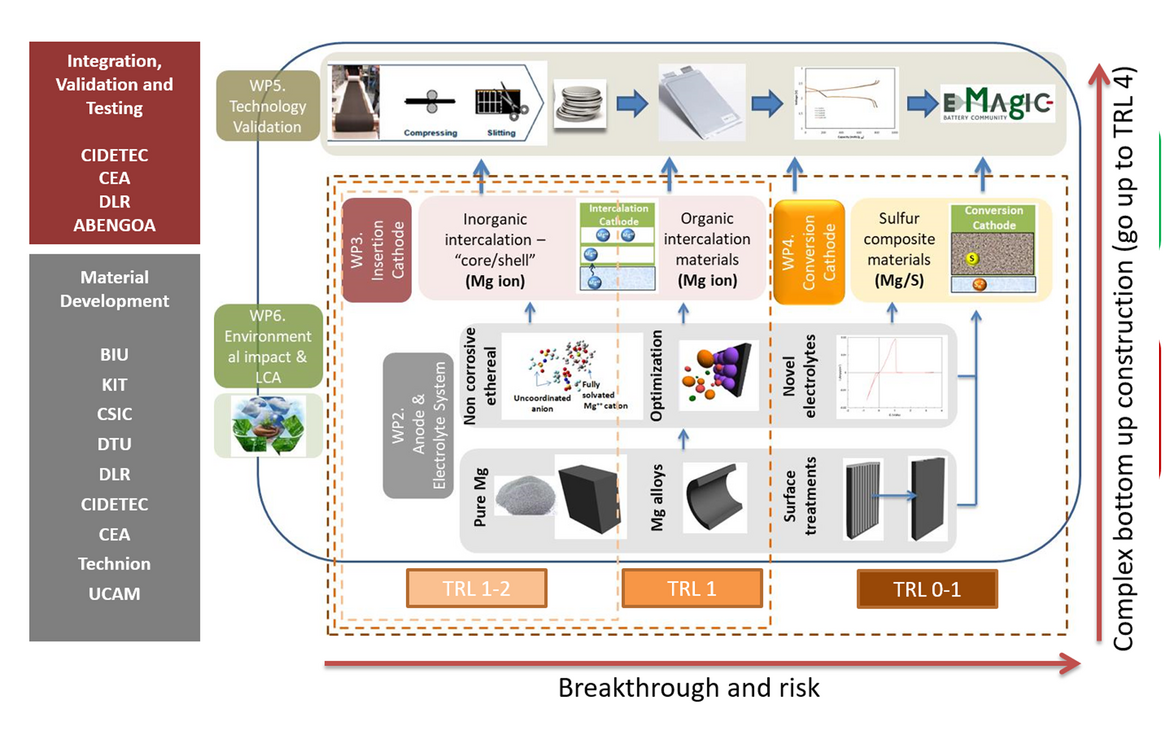European
Magnesium Interactive
Battery Community

European Commission
This project has received funding from the European Union’s Horizon 2020 research and innovation programme under grant agreement No 824066
European
Magnesium Interactive
Battery Community

This project has received funding from the European Union’s Horizon 2020 research and innovation programme under grant agreement No 824066

E-MAGIC is a high risk project itself which comprises a high scientific level consortium led by CID (WP1/WP7). Among the scientific challenges, CID and partners will reinforce and promote further the European Mg Battery Community.
BIU, CSIC, KIT, IIT, DLR and UCAM, are the pioneers in the field of Mg battery and are the most credible laboratories to achieve breakthroughs in the field of electrode and electrolytes.
BIU team (led by Prof. D. Aurbach) and IIT group focus their activities on the investigation and development of new anodes (including alloy and surface treatments) and electrolyte solutions for RMB (WP2). BIU/IIT will conduct intensive basic research that will lead at optimizing anode/electrolyte solutions systems with the support of modelling activities (DTU/DLR) and magnesium processing experts (IIT). IIT has the know-how of materials science and is able to develop, characterize and industrialize the production of magnesium anode (WP2).
KIT research team (led by Prof. M. Fichtner) has a cross-sectional function as materials developer, supplier, and tester. Together with DLR team, they will focus on the development of improved and novel solid electrolytes besides novel sulfur composites (WP4). Moreover, high voltage and alternative conversion cathode materials will be synthesized based on the outcome of the modelling work performed by DTU and DLR (WP3, WP4).
CSIC will bring its specific expertise in fundamental materials research targeting multivalent batteries. More specifically, CSIC team (led by Dr. M. Rosa Palacín) will develop synthesis routes and assess the performance of materials in perfect alignment with modelling (WP3).
CID, CEA and DLR complement activities with their expertise in the development of advanced electrodes based on other metals and containing different electrolyte systems (aqueous and non-aqueous).
The atomic-scale mechanistic insight generated by the modelling (DTU) will facilitate discovery of improved anode and cathode materials and provide kinetic data for transport models. In complement, DLR offers experience in simulations of meso- to the macro-scale. Furthermore, DLR focuses on transport and reaction processes within electrodes. Such simulations on the cell and electrode level are indispensable for rational design of optimized cells (WP5).
CID and CEA are one of the leading European Centers within Europe, for the development and scale-up of novel energy storage system until prototype level. The role of both centers in the consortium is to advise on matters related to the feasibility of scaling-up those new systems developed by E-MAGIC consortium (WP5).
CEA and ABG will evaluate the environmental impact of the technologies elaborated by the project (WP6). Ultimately, ABG as and engineering company leader in the Energy sector, will assess by simulations the hybridization feasibility of RMB in emerging Hybrid Electrochemical Storage Systems (HESS).